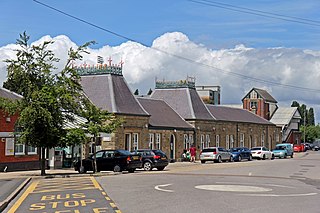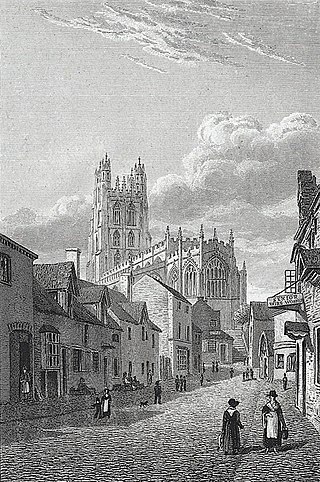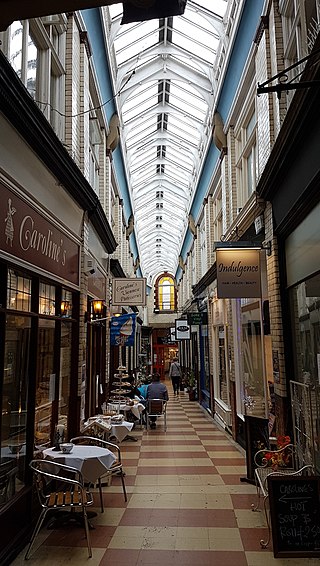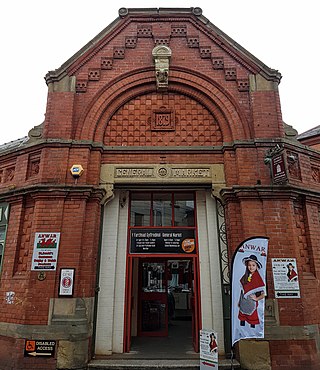
Wrexham is a city and the administrative centre of Wrexham County Borough in Wales. It is located between the Welsh mountains and the lower Dee Valley, near the border with Cheshire in England. Historically in the county of Denbighshire, and later the county of Clwyd in 1974, it has been the principal settlement of Wrexham County Borough since 1996.

Bridgend is a town in the Bridgend County Borough of Wales, 20 miles (32 km) west of Cardiff and 20 miles (32 km) east of Swansea. The town is named after the medieval bridge over the River Ogmore. The River Ewenny also flows through the town. The population was 49,597 in 2021. Bridgend is within the Cardiff Capital Region which in 2019 had a population of approximately 1.54 million.

Wrexham County Borough is a county borough, with city status, in the north-east of Wales. It borders the English ceremonial counties of Cheshire and Shropshire to the east and south-east respectively, Powys to the south-west, Denbighshire to the west and Flintshire to the north-west. The city of Wrexham is the administrative centre. The county borough is part of the preserved county of Clwyd.

North Wales is a region of Wales, encompassing its northernmost areas. It borders mid Wales to the south, England to the east, and the Irish Sea to the north and west. The area is highly mountainous and rural, with Snowdonia National Park and the Clwydian Range and Dee Valley, known for its mountains, waterfalls and trails, wholly within the region. Its population is concentrated in the north-east and northern coastal areas, with significant Welsh-speaking populations in its western and rural areas. North Wales is imprecisely defined, lacking any exact definition or administrative structure. It is commonly defined administratively as its six most northern principal areas, but other definitions exist, with Montgomeryshire historically considered to be part of the region.

Wellington is a constituent market town of Telford and a civil parish in the borough of Telford and Wrekin, Shropshire, England. It is situated 3 miles (4.8 km) northwest of Telford town centre and 12 miles (19 km) east of Shrewsbury. The summit of The Wrekin lies 3 miles southwest of the town. The population of the town was 25,554 in 2011.

Wrexham General is the main railway station serving the city of Wrexham, north-east Wales, and one of the two serving the city, alongside Wrexham Central. It is currently operated and mostly served by Transport for Wales, with some additional services provided by Avanti West Coast to London Euston.

Telford Central railway station serves the town of Telford, Shropshire, England. It is located on the Wolverhampton to Shrewsbury Line 15+1⁄2 miles (24.9 km) north west of Wolverhampton and is operated by West Midlands Trains. It is situated close to the Telford Shopping Centre, the main commercial district of the town.

The city of Wrexham in north-east Wales has a history dating back to ancient times. The former market town was the site of heavy industry in the 19th and 20th centuries, and is now an active commercial centre. Wrexham was granted city status in 2022.

Cheshire West and Chester is a unitary authority area with borough status in Cheshire, England. It was established on 1 April 2009 as part of the 2009 local government changes, by virtue of an order under the Local Government and Public Involvement in Health Act 2007. It superseded the boroughs of Ellesmere Port and Neston, Vale Royal and the City of Chester; its council assumed the functions and responsibilities of the former Cheshire County Council within its area. The remainder of ceremonial Cheshire is composed of Cheshire East, Halton and Warrington. Cheshire West and Chester has three key urban areas: Chester, Ellesmere Port and Northwich/Winsford.

Eagles Meadow is a medium-sized shopping centre in Wrexham city centre. The area has had a variety of previous uses, from housing stables for local gentry to its later use as a car park hosting a market. The current shopping centre opened on Thursday 30 October 2008 at 10am.

Wrexham bus station is an eight-stand indoor bus station in Wrexham city centre on King Street. Services provide transit within the city, elsewhere in north Wales, and to Cheshire and Shropshire in England.

Tŷ Pawb is a multi-purpose centre in Wrexham, Wales. It serves as a venue for arts, cultural and community events, as well as being a market and art gallery. A redevelopment of the former Wrexham People's Market between Chester Street and Market Street in Wrexham city centre, the community centre opened on 2 April 2018. It provides exhibitions, a gallery, a food court, small stage concerts and live events, as well as a market space for local traders and the relocation of Oriel Wrecsam. A multi-storey car park is located on top of Tŷ Pawb, on the building's upper floors.

Xplore! Science Discovery Centre, branded simply as Xplore!, is a science centre in Wrexham, Wales. It is currently based between Henblas Street and Chester Street in Wrexham city centre. Formerly known as Techniquest@NEWI and Techniquest Glyndŵr, as a sister venue to Cardiff's Techniquest, it was housed on Wrexham University's Plas Coch campus from 2003 until its relocation in 2020. The centre is operated by North Wales Science, a charity wholly owned by Wrexham University.

Wrexham Library is the main public library of Wrexham, Wales. Located in the city centre, adjacent to Llwyn Isaf, it opened in 1972, superseding the old carnegie library on Queens Square.

The Butcher's Market is an indoor market in Wrexham city centre, Wales. It is situated inside a Grade II listed building on Wrexham's High Street. Built in 1848 to the Neo-Jacobean designs of Thomas Penson and extended in 1879–80, it is one of the two dedicated indoor markets of Wrexham.

The Central Arcade, historically known as the Hope Street Arcade or Wrexham Arcade, is a shopping arcade in Wrexham city centre, Wales. Connecting Wrexham's Hope Street to the Butcher's Market, it was built in 1891.

The General Market is an indoor market in Wrexham city centre, North Wales. It is situated inside a Grade II listed building between Wrexham's Henblas Street and Chester Street on a site formerly known as Manchester Square. Built in 1879 as the Butter Market, it is one of the two dedicated indoor markets of Wrexham.

Queen's Square is a public square in Wrexham city centre, North Wales. It is located adjacent to the Wrexham Guildhall and Old Library. It is a main site for various events in the city, in particular outdoor markets.

Chester Street is a street in Wrexham city centre, North Wales. It was once a main north–south road on the edge of the centre of Wrexham. The street has several listed buildings, as well as Wrexham's civic centre containing various council, memorial and leisure buildings, Coleg Cambria's Yale campus, Tŷ Pawb and various historical buildings now demolished.























